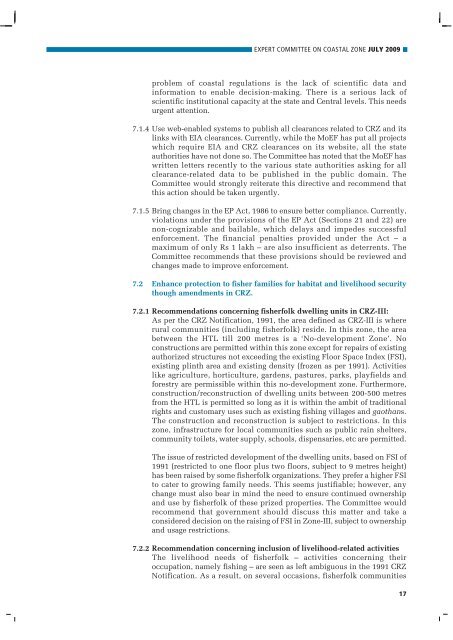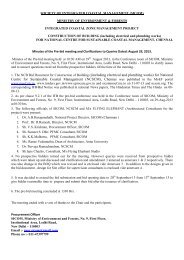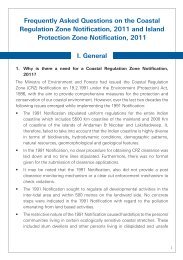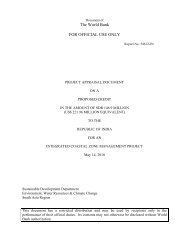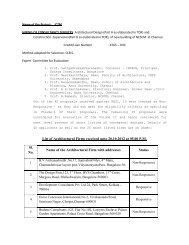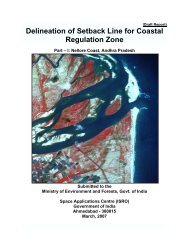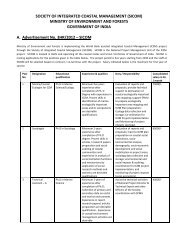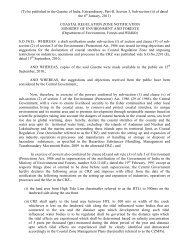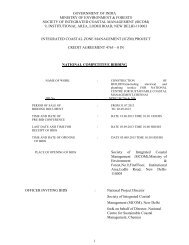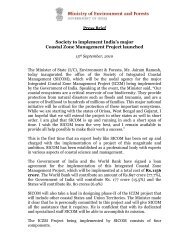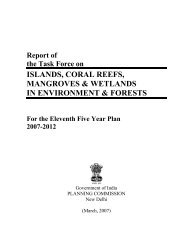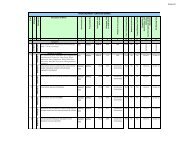FINAL FRONTIER Agenda to protect the ecosystem and ... - Sicom
FINAL FRONTIER Agenda to protect the ecosystem and ... - Sicom
FINAL FRONTIER Agenda to protect the ecosystem and ... - Sicom
You also want an ePaper? Increase the reach of your titles
YUMPU automatically turns print PDFs into web optimized ePapers that Google loves.
EXPERT COMMITTEE ON COASTAL ZONE JULY 2009<br />
problem of coastal regulations is <strong>the</strong> lack of scientific data <strong>and</strong><br />
information <strong>to</strong> enable decision-making. There is a serious lack of<br />
scientific institutional capacity at <strong>the</strong> state <strong>and</strong> Central levels. This needs<br />
urgent attention.<br />
7.1.4 Use web-enabled systems <strong>to</strong> publish all clearances related <strong>to</strong> CRZ <strong>and</strong> its<br />
links with EIA clearances. Currently, while <strong>the</strong> MoEF has put all projects<br />
which require EIA <strong>and</strong> CRZ clearances on its website, all <strong>the</strong> state<br />
authorities have not done so. The Committee has noted that <strong>the</strong> MoEF has<br />
written letters recently <strong>to</strong> <strong>the</strong> various state authorities asking for all<br />
clearance-related data <strong>to</strong> be published in <strong>the</strong> public domain. The<br />
Committee would strongly reiterate this directive <strong>and</strong> recommend that<br />
this action should be taken urgently.<br />
7.1.5 Bring changes in <strong>the</strong> EP Act, 1986 <strong>to</strong> ensure better compliance. Currently,<br />
violations under <strong>the</strong> provisions of <strong>the</strong> EP Act (Sections 21 <strong>and</strong> 22) are<br />
non-cognizable <strong>and</strong> bailable, which delays <strong>and</strong> impedes successful<br />
enforcement. The financial penalties provided under <strong>the</strong> Act – a<br />
maximum of only Rs 1 lakh – are also insufficient as deterrents. The<br />
Committee recommends that <strong>the</strong>se provisions should be reviewed <strong>and</strong><br />
changes made <strong>to</strong> improve enforcement.<br />
7.2 Enhance <strong>protect</strong>ion <strong>to</strong> fisher families for habitat <strong>and</strong> livelihood security<br />
though amendments in CRZ.<br />
7.2.1 Recommendations concerning fisherfolk dwelling units in CRZ-III:<br />
As per <strong>the</strong> CRZ Notification, 1991, <strong>the</strong> area defined as CRZ-III is where<br />
rural communities (including fisherfolk) reside. In this zone, <strong>the</strong> area<br />
between <strong>the</strong> HTL till 200 metres is a ‘No-development Zone’. No<br />
constructions are permitted within this zone except for repairs of existing<br />
authorized structures not exceeding <strong>the</strong> existing Floor Space Index (FSI),<br />
existing plinth area <strong>and</strong> existing density (frozen as per 1991). Activities<br />
like agriculture, horticulture, gardens, pastures, parks, playfields <strong>and</strong><br />
forestry are permissible within this no-development zone. Fur<strong>the</strong>rmore,<br />
construction/reconstruction of dwelling units between 200-500 metres<br />
from <strong>the</strong> HTL is permitted so long as it is within <strong>the</strong> ambit of traditional<br />
rights <strong>and</strong> cus<strong>to</strong>mary uses such as existing fishing villages <strong>and</strong> gaothans.<br />
The construction <strong>and</strong> reconstruction is subject <strong>to</strong> restrictions. In this<br />
zone, infrastructure for local communities such as public rain shelters,<br />
community <strong>to</strong>ilets, water supply, schools, dispensaries, etc are permitted.<br />
The issue of restricted development of <strong>the</strong> dwelling units, based on FSI of<br />
1991 (restricted <strong>to</strong> one floor plus two floors, subject <strong>to</strong> 9 metres height)<br />
has been raised by some fisherfolk organizations. They prefer a higher FSI<br />
<strong>to</strong> cater <strong>to</strong> growing family needs. This seems justifiable; however, any<br />
change must also bear in mind <strong>the</strong> need <strong>to</strong> ensure continued ownership<br />
<strong>and</strong> use by fisherfolk of <strong>the</strong>se prized properties. The Committee would<br />
recommend that government should discuss this matter <strong>and</strong> take a<br />
considered decision on <strong>the</strong> raising of FSI in Zone-III, subject <strong>to</strong> ownership<br />
<strong>and</strong> usage restrictions.<br />
7.2.2 Recommendation concerning inclusion of livelihood-related activities<br />
The livelihood needs of fisherfolk – activities concerning <strong>the</strong>ir<br />
occupation, namely fishing – are seen as left ambiguous in <strong>the</strong> 1991 CRZ<br />
Notification. As a result, on several occasions, fisherfolk communities<br />
17


